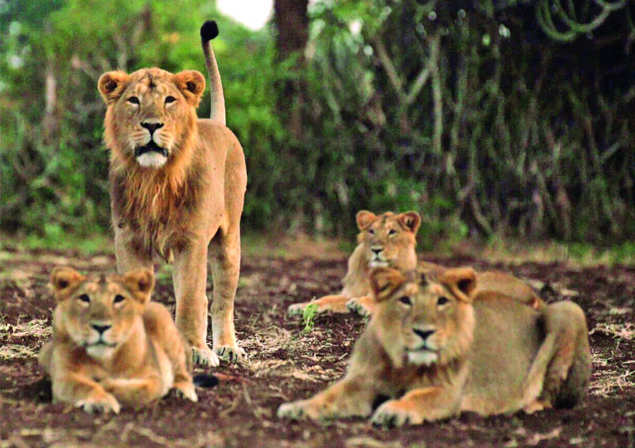Mar 27, 2020, 00:30 IST
A month and a half before the lion census starts in Gujarat, the government has rejected experts from WII and technology to conduct the head count
In Gujarat, where lion population is widely speculated to have touched the 1,000-mark, Lion Census 2020 was pegged to be different.
It was proposed to be more tech-driven with 3,000 camera traps in place and supervised by the prestigious Wildlife Institute of India. A month and half ahead of the exercise, Gujarat has reportedly rejected both WII and technology to know the exact headcount of Asiatic lions in Gir and its periphery.
Top officials in state forest department said that instead of electronic eyes, lion census will take place using the age-old method of direct sighting involving over 3,000 forest personnel and volunteers from the civil society.
“Gujarat government has written to WII stating that they have not accepted special research ahead of lion census. It has also communicated that WII will not be part of Lion Census 2020 as the state is not using the tiger census model of counting,” said a top WII source.
Shyamal Tikedar, principle chief conservator of forest (wildlife), said, “Camera traps will not be used as unlike tigers, lions are not elusive. Direct sighting is effective in counting lions in Gir and its periphery.”
It was proposed to be more tech-driven with 3,000 camera traps in place and supervised by the prestigious Wildlife Institute of India. A month and half ahead of the exercise, Gujarat has reportedly rejected both WII and technology to know the exact headcount of Asiatic lions in Gir and its periphery.
Top officials in state forest department said that instead of electronic eyes, lion census will take place using the age-old method of direct sighting involving over 3,000 forest personnel and volunteers from the civil society.
“Gujarat government has written to WII stating that they have not accepted special research ahead of lion census. It has also communicated that WII will not be part of Lion Census 2020 as the state is not using the tiger census model of counting,” said a top WII source.
Shyamal Tikedar, principle chief conservator of forest (wildlife), said, “Camera traps will not be used as unlike tigers, lions are not elusive. Direct sighting is effective in counting lions in Gir and its periphery.”
Camera traps will not be used as unlike tigers, lions are not elusive. Direct sighting is effective in counting lions in Gir and its periphery
The 2015 Lion Census revealed 523 big cats in Gir and its periphery. However, the lion population is reported to be burgeoning as is visible from the rising number of lion movement in villages and even towns.
Lion footprints are now widely recorded in 22,000 sq km area in seven districts of Gujarat. While CM Vijay Rupani in 2017 had pegged Gujarat to have 600 lions, the numbers are speculated to have crossed 1,000.

Forest officials and wildlife experts said that there is more to the change of plan than meets the eye in not including WII in lion census.
A senior official termed this as a result of “political considerations in wildlife management” where the state is loathe to admit “real numbers”. “Involvement of WII and cameras would have put pressure to record real numbers,” said a top source in the forest department.
"Officially high number of lions can create panic in people. Secondly, it could lead to pressure on the state to shift lions to Madhya Pradesh. Thirdly, it could undermine its census methods,” said a senior wildlife expert.
Sources said that government, at best, is keen to show 30% rise in lion numbers.
Lion footprints are now widely recorded in 22,000 sq km area in seven districts of Gujarat. While CM Vijay Rupani in 2017 had pegged Gujarat to have 600 lions, the numbers are speculated to have crossed 1,000.

Gujarat: The last abode of Asiatic lion
Once widespread, in the early 20th century the lion population shrank to a dozen due to hunting and drought.
Nawab Mahabat Khanji of then Junagadh state, an animal lover banned lion hunting and preserved the big cat.
Today, lions are found across the 25,000 sqkm area of the Saurashtra region - which includes Junagadh and 10 other districts - and are routinely spotted on private farms and near village homes
The lion census is carried out every five years. This year it will be spread across 25,000 sqkm spanning seven districts as against 15,000 sqkm area in 2015. The number of lions are expected to rise this census from 523 in 2015.
Forest officials and wildlife experts said that there is more to the change of plan than meets the eye in not including WII in lion census.
A senior official termed this as a result of “political considerations in wildlife management” where the state is loathe to admit “real numbers”. “Involvement of WII and cameras would have put pressure to record real numbers,” said a top source in the forest department.
"Officially high number of lions can create panic in people. Secondly, it could lead to pressure on the state to shift lions to Madhya Pradesh. Thirdly, it could undermine its census methods,” said a senior wildlife expert.
Sources said that government, at best, is keen to show 30% rise in lion numbers.

https://timesofindia.indiatimes.com/india/gujarat-want-to-count-its-lions-minus-the-tech/articleshow/74590755.cms
No comments:
Post a Comment